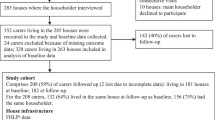Abstract
The impact of housing and neighborhood context on children’s mental health, as addressed by Flouri et al. (Soc Psychiatry Psychiatr Epidemiol, 2014), is an important, understudied topic in social epidemiology. Although the vast majority of this body of research has been descriptive, generating translational research is essential. This article offers guidance on interpreting evidence from observational studies for translation into policy, related to three policy-relevant elements of housing: receipt of affordable housing subsidies, the target population to which results generalize, and operationalization and modeling of neighborhood context. Policy translation is imperative for understanding which levers outside the health sector can be manipulated to change fundamental causes of mental health related to housing and neighborhood. Shifting from policy relevance to policy translation may be challenging, especially for understanding social causation in observational studies, but it is a necessary shift for improving population health.
Similar content being viewed by others
References
Flouri E, Midouhas E, Tzatzaki K (2014) Neighbourhood and own social housing and early problem behaviour trajectories. Soc Psychiatry Psychiatr Epidemiol. doi:10.1007/s00127-014-0958-1
Osypuk TL (2013) Future research directions for understanding neighborhood contributions to health disparities. Rev Epidemiol Sante Publique 61(Supplement 2):S61–S68. doi:10.1016/j.respe.2013.03.040
Osypuk TL, Joshi P, Geronimo K, Acevedo-Garcia D (2014) Do social and economic policies influence health? A review. Curr Epidemiol Rep 1(3):149–164. doi:10.1007/s40471-014-0013-5
Osypuk TL, Tchetgen Tchetgen EJ, Acevedo-Garcia D, Earls FJ, Lincoln AK, Schmidt NM, Glymour MM (2012) Differential mental health effects of neighborhood relocation among youth in vulnerable families: results from a randomized trial. Arch Gen Psychiatry 69(12):1284–1294. doi:10.1001/archgenpsychiatry.2012.449
Pattison B, Diacon D, Vine J (2010) Tenure trends in the UK Housing System: will the private rented sector continue to grow?. Building and Social Housing Foundation, Leicestershire
Manjarrez CA, Popkin SJ, Guernsey E (2007) Poor health: adding insult to injury for HOPE VI families. Metropolitan Housing and Communities Center. The Urban Institute, Washington
Cole SR, Frangakis CE (2009) The consistency statement in causal inference: a definition or an assumption? Epidemiology 20(1):3–5. doi:10.1097/EDE.1090b1013e31818ef31366
Hernán MA, Alonso A, Logan R, Grodstein F, Michels KB, Willett WC, Manson JE, Robins JM (2008) Observational studies analyzed like randomized experiments: an application to postmenopausal hormone therapy and coronary heart disease. Epidemiology 19(6):766–779. doi:10.1097/EDE.0b013e3181875e61
Acevedo-Garcia D, McArdle N, Hardy EF, Crisan UI, Romano B, Norris D, Baek M, Reece J (2014) The child opportunity index: improving collaboration between community development and public health. Health Aff 33(11):1948–1957. doi:10.1377/hlthaff.2014.0679
Handy S, Xinyu C, Mokhtarian PL (2006) Self-selection in the relationship between the built environment and walking. J Am Plan Assoc 72(1):55–74. doi:10.1080/01944360608976724
Acknowledgments
I thank M. Maria Glymour for comments on a prior draft of this article. This article was supported by National Institutes of Health funding from Grants R01MD006064 and R03HD080848 (PI: Osypuk).
Conflict of interest
The author has no conflict of interest.
Author information
Authors and Affiliations
Corresponding author
Rights and permissions
About this article
Cite this article
Osypuk, T.L. Shifting from policy relevance to policy translation: do housing and neighborhoods affect children’s mental health?. Soc Psychiatry Psychiatr Epidemiol 50, 215–217 (2015). https://doi.org/10.1007/s00127-014-0998-6
Received:
Accepted:
Published:
Issue Date:
DOI: https://doi.org/10.1007/s00127-014-0998-6




